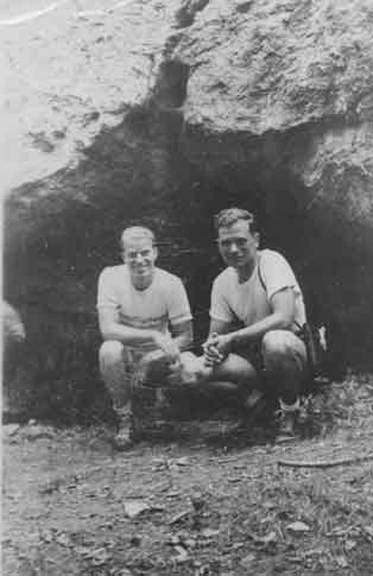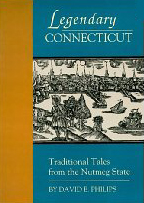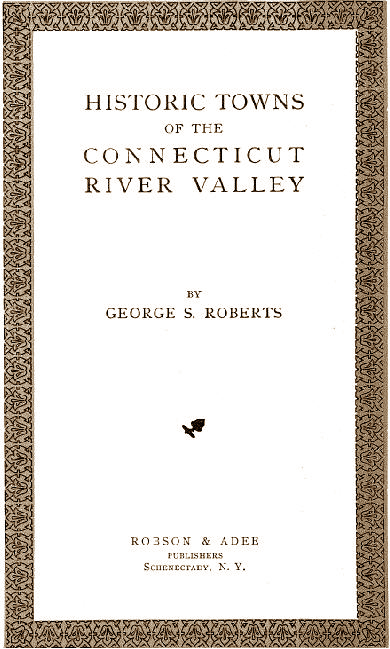|
 The Moodus Noises
& Moodus Noise Cave The Moodus Noises
& Moodus Noise Cave
By
Daniel V. Boudillion
14
December 2009
According
to local legend, the Moodus Noises can be heard most clearly issuing
from the cave on Cave Hill, which is adjacent to Mt. Tom. The site
is owned by the
Cave Hill Resort in Moodus, Connecticut.
Alison Guinness, a Moodus high school science
teacher who did her master's thesis on the Moodus Noises confirms this
legend and says, "The noise is most prevalent near the opening of a cave
in a local hill called Mount Tom. I believe the noise of shifting
rock formations underground is amplified by the cave." She goes on
to say that the local Indians, the Wangunks, "had a religious cult based
on the noises." [Connecticut
Town is Known for Its Mysterious Noises, 31 October 1985, Charles
Hillinger]
.
Entrance to "Moodus Noises" cave on
Cave Hill, 1940s
Geologists claim to have solved the
mystery of the Moodus Noises. For example, the 19 October 1981
edition of the Harford Courant ran an article entitled "Seismic
Detective Solves 'Moodus Noises' Mystery." The cause, according to
the article, are shallow "micro-earthquakes."
Agreement with Guinness's theory of an Indian
"religious cult based on the noises" is provided by David E. Philips in
Legendary Connecticut, published in 1984. Like Mavor & Dix
concluded in Manitou, he feels that the Moodus area was a focal
point for Native American religious activity revolving around Hobomock
and the noises. Similarly, he also feels it that it was a
truce-zone and Sachems from all over New England visited Moodus to seek
vision-quest, guidance, and appeasement of Hobomock, as follows:
 "For
the earliest inhabitants of this region, the people of the Pequot,
Mohegan and Narragansett tribes, the thundering and quaking around
Mount Tom were evidence of the living presence of the god Hobomoko,
who sat below on a sapphire throne and decreed all human calamity.
The Indians called the area "Matchemadoset" or "Matchitmoodus" --
now "Machimoodus" -- meaning, literally, "Place of Bad Noises."
Since Hobomoko's thunder was sometimes loud and violent and at
other times soft and gentle, it was said that Connecticut's
Indians depended upon the local Machimoodus tribe to interpret the
many voices of the evil deity. Living, as they did, in the
shadow of sacred Mount Tom, the pious men of the Machimoodus were
thought by others to have direct access to the raging spirit
beneath its slopes. "For
the earliest inhabitants of this region, the people of the Pequot,
Mohegan and Narragansett tribes, the thundering and quaking around
Mount Tom were evidence of the living presence of the god Hobomoko,
who sat below on a sapphire throne and decreed all human calamity.
The Indians called the area "Matchemadoset" or "Matchitmoodus" --
now "Machimoodus" -- meaning, literally, "Place of Bad Noises."
Since Hobomoko's thunder was sometimes loud and violent and at
other times soft and gentle, it was said that Connecticut's
Indians depended upon the local Machimoodus tribe to interpret the
many voices of the evil deity. Living, as they did, in the
shadow of sacred Mount Tom, the pious men of the Machimoodus were
thought by others to have direct access to the raging spirit
beneath its slopes.
Thus, when Hobomoko spoke, the
resident medicine-men listened. Then, as chieftains from
other tribes gathered with their offerings, the Machimoodus
priests would engage in great powwows, finally emerging with the
right formula for calming the angry god through sacrifice and
prayer. They say that many were the times when the
Machimoodus medicine-men were kept very busy consulting with
visiting sachems and preparing offerings to the underground
deity."
George S. Roberts gives a lively account of
the Moodus Legends in his 1906 book
Historic Towns of the Connecticut River Valley. This is
particularly worthwhile as he quotes the 1729 Hosmer letter in full.
Robert's chapter on the Town of Moodus is as follows:

The village of Moodus takes its name from
an Indian word, Machirnoodus, meaning in English place of noises.
The Indians occupying the territory now East Haddam, were given over
to superstition, even more so than the majority of Indians in other
parts of the Connecticut Valley. There was a fierce savagery in
their superstition, resembling that of the African savage more than
that of the New England savage, whose superstition was of a gentler,
more poetic nature. As a result, the Moodus Indians were fierce,
cruel and war-like. As early as 1729, the Rev. Stephen Hosmer wrote
to a friend in Boston describing these strange noises, from which
Moodus takes its name:
"As to earthquakes, I nave something
considerable and awful to tell you. Earthquakes have been here, as
has been observed for more than thirty years. I have been informed
that in this place, before the English settlements, there were great
numbers of Indian inhabitants, and that it was a place of
extraordinary pawaws, or in short, that it was a place where the
Indians drove a prodigious trade in worshipping the devil.
Also I was informed, that many years past, an old Indian was asked
the reason of the noises in this place, to which he replied, that
"the Indians' God was very angry that the Englishman's God was come
there." Now, whether there be anything diabolical in these
things, I know not; but this I know, that God Almighty is to be seen
and trembled at, in what has been often heard among us. Whether it
be fire or air distressed in the caverns of the earth, cannot be
known ; for there is no eruption, no explosion perceptible, but by
sounds and tremors, which sometimes are very fearful and dreadful. I
have myself, heard eight or ten sounds successively, and imitating
small arms, in the space of five minutes. I have, I suppose, heard
several hundred of them within twenty years; some more, some less
terrible. Sometimes we have heard them almost every clay, and great
numbers of them in the space of a year. Oftentimes I have observed
them to be coming down from the north, imitating slow thunder, until
the sound came near, or right under, and then there seemed to be a
breaking, like the noise of a cannon shot, or severe thunder, which
shakes the houses and all that is in them. They have in a manner
ceased since the great earthquake. As I remember, there have been
but two heard since that time and these but moderate."
In the year 1831, or '32, about one
hundred years after Mr. Hosmer's, the following account was given by
a gentleman who had heard the noises.
"The awful noises about which Mr. Hosmer
gave an account continue to the present time. The effects they
produce are various as the intermediate degrees between the roar of
a cannon and the noise of a pistol. The concussions of the earth,
made at the same time, are as much diversified as the sounds in the
air. The shock they give to a dwelling house, is the same as the
falling of logs on the floor. But when they are so violent as
to be felt in the adjacent towns, they are called earthquakes.
During my residence here, which has been almost thirty-six years, I
have invariably observed that an account has been published in the
newspapers, of a small shock of earthquake, in New London and
Hartford. Nor do I believe, in all that period, there has been any
account published of an earthquake in Connecticut, which has not
been far more violent here than in any other place."
On the night of May 18, 1791, about ten
o'clock, there was an earthquake so violent that it was felt in New
York and Boston. The first shock was followed by another in a few
minutes that was felt at a distance of seventy miles. In Moodus and
the neighboring places, the roaring noises and shaking of the earth
were great. Walls were thrown down and the tops of chimneys were
thrown to the ground. And while but two shocks were felt at a
distance, there were in Moodus and the surrounding country between
twenty and thirty shocks felt. It was found the next day that the
earth was cracked in several places and that great boulders weighing
many tons had been moved.
There is a tradition in regard to a
certain Dr. Steele and the Moodus-noises, which goes to show that
the white settlers were (when their superior enlightenment,
education, and Christian faith is considered), as superstitious as
were the Indians. Dr. Steele was an Englishman, but where he came
from, how he beard about the noises, or what reason he had for
believing that he could remove from their pockets to his, the
shillings and pence of the trusting and superstitious white-men, by
means of the art of enchantment, has not been recorded.
This Dr. Steele told the people that the
noises and disturbances were caused by a great carbuncle that was
confined in a large rock in the bowels of the earth and that he, by
his magic, could remove the carbuncle and so stop the noises. Dr.
Steele, being a man of " much book-learning " the people absorbed
his words and entered into some kind of agreement with him. The
doctor then secured a blacksmith's shop, plugged the windows,
cracks, holes and doorways so that no light could enter, nor the
prying gaze of the awe-inspired people discover his secret. He
worked at night, as all such mysterious persons do, and when the
people saw the vast cloud of smoke, lighted by flame and thousands
of sparks, they felt sure that Dr. Steele and Satan were raising
Hell, and that the great carbuncle would come up with it.
While his dread work was going on, Dr.
Steele told the people, on the rare occasions when he consented to
let himself be seen, that he had located the great carbuncle and
that he could remove it and so stop the worst of the shakes and
noises, but that he had discovered some smaller carbuncles which
would, as time went on, cause more noises but not nearly so
terrible. At last the cause of the trouble was removed and Dr.
Steele immediately disappeared, never to be seen again by Moodus
people. It so happened that the noises ceased for a time and were
never again so violent. The people were convinced that Dr. Steele
was a wizard, if not a close relation to his Majesty of the nether
world. Mr. J. G. C. Brainard, editor of the Hartford Mirror, wrote a
poem of thirteen verses (fatal number) on the subject of Dr. Steele
and the great carbuncle, from which the following are quoted:
See you upon the lonely moor,
A crazy building rise?
No hand dares venture to open the
door —
No footstep treads its dangerous
floor —
No eye its secret pries.
Now why is each crevice stopped so
tight?
Say, why the bolted door?
Why glimmers at midnight the forge's
light?
All day is the anvil at rest, but at
night
The flames of the furnace roar.
Woe to the bark in which he flew
From Moodus rocky shore —
Woe to the captain and woe to the
crew,
That ever the breath of life they
drew,
When that dreadful freight they
bore.
Where is that crew and vessel now?
Tell me their state who can,
The wild waves clashed o're the
sinking bow —
Down, down to the fathomless depths
they go —
To sleep with a sinful man.
The carbuncle lies in the deep sea,
Beneath the mighty wave;
But the light shines up so
gloriously
That the sailor looks pale and
forgets his glee,
When he crosses the wizard's grave.
|